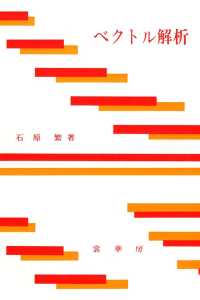- ホーム
- > 洋書
- > 英文書
- > Computer / General
Full Description
A book akin to "Visualize This" but with a FloatingSheep sensibility defined as Mapping (1) should be both fun and also try to change the world; (2) provide an ongoing critique/reflection of the data (particularly social media data), the cartographic process and the final map; (3) provide useful, technical instruction on how to make well designed interactive maps with spatial analysis; (4) emphasize a clear geographic sensibility (building from the cartographic process) that distinguishes it vis-a-vis data visualization, e.g., using big data or user generated data to systematically deploy geoviz tools to seek meaning to questions. At the end of the book, someone will be a critically informed, technically skilled 21st century map-maker. Four Key Topics What is a Map? Reviewing what can be mapped, different types of maps and telling stories with maps. The previously existing practice of "the map" (expert-created, static, generalized) is being transformed into an era of "maps" (open-source, dynamic, online, user-generated). Data for Maps: Using the metaphor of the Data Monster (riffing off the Cookie Monster, "D is for data and that's good enough for me") as a critique of simplistic data use . Identifying key traditional data sources (Census) and outlining ways to use APIs to get social media data; perhaps collecting GPS data on one's own. For many of the cases we'll rely on user-generated social media data but we'll draw upon some other data sets as well. Mapping Case Studies: Four key chapters are case studies on two "fun" and "world-changing" topics through which the cartographic process will be on display. In addition to how-to code, we will also tie back in the big ideas of data and maps introduced in earlier chapters. The cases will be beer, sex, measles, and climate change. Optimizing Maps: Emphasizing the design and question/problem solving aspects of mapping; the seven (or 8 or 9) most common mistakes of first time mappers; Exploring how different technical mapping decisions (categorization, colors, labels, etc.) could have produced very different results in the case studies.








